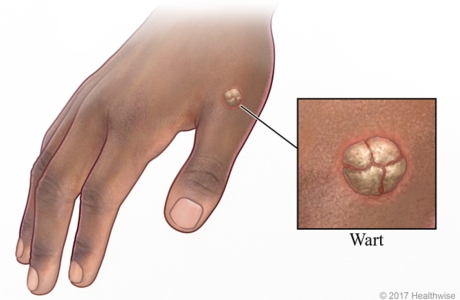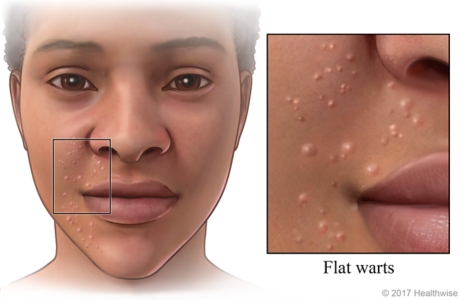Warts and Plantar Warts
Condition Basics
What are warts?
Warts are skin growths caused by a virus. Warts can grow anywhere on the body. There are different kinds. For example, common warts grow most often on the hands, but they can grow anywhere. Plantar warts grow on the soles of the feet. Most warts go away on their own within months or years.
How do they spread?
Warts are spread by direct contact with a human papillomavirus (HPV). You can infect yourself again by touching the wart and then touching another part of your body. You can infect another person by sharing towels, razors, or other items. After contact with HPV, it can take months before you notice a wart.
What are the symptoms?
A wart may be a bump with a rough surface, or it may be flat and smooth. Plantar warts can look like a callus. Warts are usually painless. But a wart that grows in a spot where you put pressure, such as on a finger or the bottom of the foot, can be painful.
How are they diagnosed?
A doctor usually can tell if a skin growth is a wart by looking at it. Your doctor may take a sample of the wart if it isn't clear that the growth is a wart or if the growth is darker than the skin around it, is irregular, bleeds, or is large and fast-growing.
How are warts treated?
Most warts don't need treatment. They generally go away on their own. But if you have warts that are painful or are spreading, you can treat them with salicylic acid or duct tape. Or your doctor can treat them with medicine or by freezing or removing them.
Cause
A wart is caused by some types of the virus called the human papillomavirus (HPV). HPV infects the top layer of skin. It usually enters the body in an area of broken skin. The virus causes the top layer of skin to grow very fast, forming a wart.
Prevention
The main way to prevent warts is to avoid contact with the human papillomavirus (HPV) that causes warts. If you are exposed to this virus, you may or may not get warts, depending on how susceptible you are to the virus. Here are some tips to help avoid HPV.
- Avoid touching warts on yourself or others.
- Don't share razors, towels, socks, or shoes with another person.
Someone with no visible warts can still be carrying the virus.
- Avoid walking barefoot on warm, moist surfaces where the wart virus may be alive.
Wear shower shoes when using public showers, locker rooms, or pool areas.
- Keep your feet dry.
If your feet sweat heavily, wear socks that absorb moisture or wick it away from the skin.
- Avoid irritating the soles of your feet.
Warts grow more easily if your skin has been injured or broken in some way.
You can help prevent warts from spreading. Keep your warts covered with a bandage or athletic tape. Don't bite your nails or cuticles, as this may spread warts from one finger to another.
Symptoms
Plantar warts

Plantar warts occur on the soles of the feet. They look like hard, thick patches of skin with dark specks. Multiple plantar warts can form in a large, flat cluster known as a "mosaic wart."
Common warts

Common warts appear most often on the hands. But they may appear anywhere on the body. They are rough, gray-brown, dome-shaped growths. They may have a cauliflower-like appearance.
Flat warts

Flat warts are usually found on the face, arms, or legs. They are small (usually smaller than the eraser on the end of a pencil), and there are usually several in one area. They have flat tops and can be pink, light brown, or light yellow. Flat warts are often spread by shaving.
When to Call a Doctor
See your doctor if:
- You aren't sure if a skin growth is a wart.
- Nonprescription home treatment isn't successful after 2 to 3 months.
- Warts are growing or spreading rapidly despite treatment.
- Signs of infection develop. These may include:
- Increased pain, swelling, warmth, or redness.
- Red streaks leading from the area.
- Pus draining from the area.
- A fever.
- A plantar wart becomes too painful to walk on.
- You have diabetes or peripheral arterial disease and you need treatment for a wart on a leg or foot.
- You have warts on your genitals or around the anus.
Watchful waiting
Watchful waiting is a wait-and-see approach. It's often okay to try this approach with warts, because they generally go away on their own within months or years. But you may want to consider treating a wart to prevent it from spreading to other parts of your body or to other people. You can try a nonprescription wart treatment for 2 to 3 months before deciding to see a doctor.
Treatment Overview
Most warts don't need treatment. They generally go away on their own within months or years. But if you have warts that are painful or are spreading, or if you're bothered by the way they look, your treatment choices include:
- Using a home treatment such as salicylic acid or duct tape. You can get these without a prescription.
- Putting a stronger medicine on the wart, or getting a shot of medicine in it.
- Freezing the wart (cryotherapy). There is an over-the-counter medicine you can use at home. Or you can have your doctor freeze it for you.
- Removing the wart with surgery (electrosurgery, curettage, laser surgery).
Surgery is more likely to leave scars. That's why it's mostly used to treat warts that are hard to remove or that keep coming back.
Wart treatment doesn't always work. Even after a wart shrinks or goes away, warts may come back or spread to other parts of the body. This is because most treatments destroy the wart but don't kill the virus that causes the wart.
Learn more
Self-Care
- Use salicylic acid or duct tape as your doctor directs. You put the medicine or the tape on a wart for several days and then file down the dead skin on the wart. You use the salicylic acid treatment for 2 to 3 months or the tape for 1 to 2 months.
- If your doctor prescribes medicine to put on warts, use it exactly as directed. Call your doctor if you think you are having a problem with your medicine.
To avoid spreading warts
- Keep warts covered with a bandage or athletic tape.
- Don't bite your nails or cuticles. This may spread warts from one finger to another.
Reducing pain caused by plantar warts
Plantar warts can be on any part of the foot. But they cause the most discomfort when they are on a pressure point such as the heel. You can help reduce plantar wart pain by doing these things.
- Wear comfortable shoes and socks.
Avoid high heels and shoes that increase pressure on your foot.
- Pad the wart with doughnut-shaped felt or a moleskin patch.
Place the pad around the plantar wart so that it relieves pressure on the wart. Also, consider placing pads or cushions in your shoes to make walking more comfortable. You can buy moleskin patches at a drugstore.
- Try nonprescription medicines, such as aspirin, ibuprofen (such as Advil), or acetaminophen (such as Tylenol) to help relieve pain.
Do not give aspirin to anyone younger than 20, because of the risk of Reye syndrome, a serious but rare illness. Be safe with medicines. Read and follow all instructions on the label.
Learn more
Related Information
Credits
Current as of: December 4, 2024
Author: Ignite Healthwise, LLC Staff
Clinical Review Board
All Ignite Healthwise, LLC education is reviewed by a team that includes physicians, nurses, advanced practitioners, registered dieticians, and other healthcare professionals.
Current as of: December 4, 2024
Author: Ignite Healthwise, LLC Staff
Clinical Review Board
All Ignite Healthwise, LLC education is reviewed by a team that includes physicians, nurses, advanced practitioners, registered dieticians, and other healthcare professionals.


